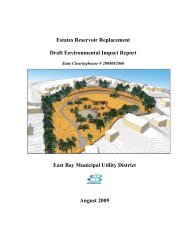Staff Reports - East Bay Municipal Utility District
Staff Reports - East Bay Municipal Utility District
Staff Reports - East Bay Municipal Utility District
Create successful ePaper yourself
Turn your PDF publications into a flip-book with our unique Google optimized e-Paper software.
Christina Ferracane, Planner II<br />
January 22, 2013<br />
Page 5<br />
needed, as noted above. Chapter 2 of the 2010 UWMP describes potential supplemental water<br />
supply projects that could be implemented to meet projected long-term water demands during<br />
multi-year drought periods.<br />
The Freeport Regional Water Facility became operational in February 2011. EBMUD's ability to<br />
take delivery of water through the Freeport facility is based on its Long Term Renewal Contract<br />
(LTRC) with the U.S. Bureau of Reclamation. The LTRC provides for up to 133,000 acre-feet in<br />
a single dry-year, not to exceed a total of 165,000 acre feet in three consecutive dry years. Under<br />
the LTRC, the CVP supply is available to EBMUD only in dry years when EBMUD's total<br />
stored water supply is forecast to be below 500 total acre feet on September 30 of each year.<br />
Construction of the <strong>Bay</strong>side Groundwater Project, Phase 1, was completed in 2010. A permit<br />
from the Department of Public Health, which is pending, is required before the groundwater can<br />
be extracted and treated for municipal use. The project is designed to yield 2 mgd over a 6-month<br />
period, resulting in an average annual production capacity of 1 mgd per year.<br />
Chapter 2 of the 2010 UWMP also lists other potential supplemental water projects, including<br />
northern California water transfers, <strong>Bay</strong>side Groundwater Project Expansion, Los Vaqueros<br />
Expansion and others that could be implemented as necessary to meet the projected long-term<br />
water supplemental need during multi-year drought periods. The 2010 UWMP identifies a broad<br />
mix of projects, with inherent scalability and the ability to adjust implementation schedules for a<br />
particular component, so that EBMUD will be able to continue to pursue the additional<br />
supplemental supplies that are projected to be necessary, while also minimizing the risks<br />
associated with future uncertainties such as project implementation challenges and global climate<br />
change. The Environmental Impact Report that EBMUD certified for the Water Supply<br />
Management Program 2040 examined the impacts of pursuing these supplemental supply<br />
projects at a program level. Separate project-level environmental documentation will be<br />
prepared, as appropriate, for specific components as they are developed in further detail and<br />
implemented in accordance with EBMUD's water supply needs.<br />
In addition to pursuing supplemental water supply sources, EBMUD also maximizes resources<br />
through continuous improvements in the delivery and transmission of available water supplies,<br />
and investments in ensuring the safety of its existing water supply facilities. These programs,<br />
along with emergency interties and planned water recycling and conservation efforts, would<br />
ensure a reliable water supply to meet projected demands for current and future EBMUD<br />
customers within the current service area.<br />
The Lake Merritt Station Area Plan presents an opportunity to incorporate water conservation<br />
measures. Conditions of approval for the implementation of the Lake Merritt Station Area Plan<br />
should require that the project comply with the California Model Water Efficient Landscape<br />
Ordinance (Division 2, Title 23, California Code of Regulations, Chapter 2.7, Sections 490<br />
through 495). EBMUD staff would appreciate the opportunity to meet with project sponsors to

















